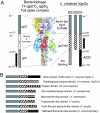Type VI secretion system translocates a phage tail spike-like protein into target cells where it cross-links actin
- PMID: 17873062
- PMCID: PMC2000545
- DOI: 10.1073/pnas.0706532104
Type VI secretion system translocates a phage tail spike-like protein into target cells where it cross-links actin
Abstract
Genes encoding type VI secretion systems (T6SS) are widely distributed in pathogenic Gram-negative bacterial species. In Vibrio cholerae, T6SS have been found to secrete three related proteins extracellularly, VgrG-1, VgrG-2, and VgrG-3. VgrG-1 can covalently cross-link actin in vitro, and this activity was used to demonstrate that V. cholerae can translocate VgrG-1 into macrophages by a T6SS-dependent mechanism. Protein structure search algorithms predict that VgrG-related proteins likely assemble into a trimeric complex that is analogous to that formed by the two trimeric proteins gp27 and gp5 that make up the baseplate "tail spike" of Escherichia coli bacteriophage T4. VgrG-1 was shown to interact with itself, VgrG-2, and VgrG-3, suggesting that such a complex does form. Because the phage tail spike protein complex acts as a membrane-penetrating structure as well as a conduit for the passage of DNA into phage-infected cells, we propose that the VgrG components of the T6SS apparatus may assemble a "cell-puncturing device" analogous to phage tail spikes to deliver effector protein domains through membranes of target host cells.
Conflict of interest statement
The authors declare no conflict of interest.
Figures





References
Publication types
MeSH terms
Substances
Grants and funding
LinkOut - more resources
Full Text Sources
Other Literature Sources
Molecular Biology Databases
Miscellaneous

